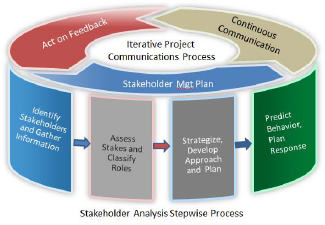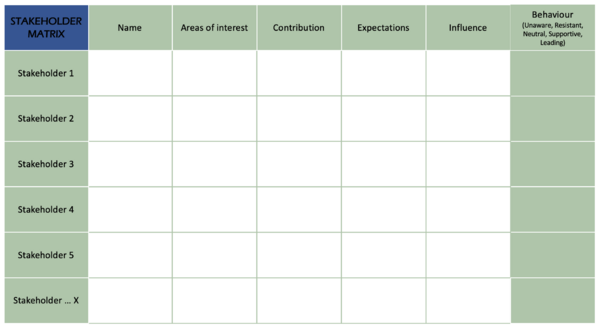Assessment of stakeholders (analysis)
Developed by Carl Bygum Knudsen
Contents |
Abstract
The assessment of stakeholders is a crucial element of any project or business strategy. It involves identifying, analyzing, and evaluating the stakeholders’ interests, potential, and influence to determine the best way to manage and interact with them. Stakeholder assessment, in essence, is the categorization and classification of stakeholders in a way that clarifies how each individual stakeholder should be managed.
This wiki article provides a comprehensive overview of the assessment of stakeholders, including a discussion of the key steps involved, some of the tools and techniques used, and the best practices. The critical steps of the assessment process will be discussed followed by the different tools and techniques used to assess stakeholders at each step. Stakeholder assessment is a broad subject and the article includes and briefly describes tools that assist the overall process of stakeholder analysis such as Stakeholder Mapping, Stakeholder Register, Power-Interest Grid and Stakeholder Action Plan. The wiki article will touch upon these subjects but focus on decision-making techniques such as the Power-Interest Grid, which allow for the assessment and prioritization of stakeholders.
Finally, the wiki article will outline some of the potential challenges and risks associated with stakeholder assessment. These include the potential for conflict of interest, unequal access to resources, and difficulty in managing stakeholders with differing interests. In general, this article provides a comprehensive overview for project managers to understand and implement the assessment of stakeholders and the key steps, tools, and best practices involved.
Introduction
According to the PMI standard, "the purpose of stakeholder engagement is to enable the needs, interests and concerns of stakeholders to be identified, understood and addressed sufficiently to enable the objectives to be met "[1]. Stakeholder assessment is a part of the larger and more complex task of stakeholder engagement - and later management of those stakeholders. It is the initial process in stakeholder analysis of providing a clear understanding of stakeholders' interests and expectations. While stakeholder management is the overarching concept and the ongoing process of engaging and meeting the expectations of stakeholders, stakeholder assessment is increasingly focused on understanding the way a stakeholder may impact a project. To effectively deliver the outcomes of a project, a project manager needs to be capable of systematically gathering and analysing information about the stakeholder to prioritize the various interests.
Stakeholder analysis is the art of knowing the entities and persons that will or can be impacted by the endeavours that you as a project manager strive to achieve. Getting the stakeholder management, and subsequently, the stakeholder assessment right in the first place is a vital cornerstone in any project and a key element towards project success. To gain a thorough understanding of stakeholder assessment, it is crucial to explain the steps of stakeholder assessment in detail [2].
Tags: Stakeholders, stakeholder assessment, stakeholder analysis, stakeholder management, stakeholder prioritisation, Power-Interest Grid, Salience Model, stakeholder mapping, stakeholder power, stakeholder influence, Project Management, Portfolio Management, Program Management
Stakeholder Assessment Process
Each step is outlined to give the reader a context, however, the actual stakeholder assessment primarily takes place in steps 3 & 4, as illustrated in Figure 1 or shown in the stakeholder management plan phase, step 2 & 3, of Figure 2. The tools connected to each step are merely suggestions and it is a non-exhaustive list of tools as stakeholder is a vast topic. The article will have a higher focus on the 3rd step and the tools that are relevant for this phase of stakeholder assessment, as it will be applied to a case company. It is relevant to note, that these steps recur in various other guides on stakeholder management and stakeholder analysis, and literature often uses these definitions interchangeably. In the section, "Tools & Techniques ", selected tools and techniques are presented to equip the project manager with the necessary knowledge to perform each step of the stakeholder assessment. In the following to models, shows two classical ways of understanding stakeholder engagement and management processes [1] [3].
Identification: Brainstorm on and document stakeholders
Stakeholder identification is crucial to the success of any project, as it ensures that all individuals or groups affected by the project are identified and their needs and expectations are taken into account. This process is ongoing, iterative and requires effort to determine who will be impacted by the project, as well as to manage them throughout the project life cycle [3]. To start the identification process, it is important to review relevant project documents, organizational policies, and guidelines to identify stakeholders who may have regulatory requirements that need to be taken into account. Brainstorming with a diverse group of individuals can be beneficial to identify essential stakeholders who may not have been identified. A comprehensive stakeholder identification plan can be created using techniques such as stakeholder mapping, project charter, and stakeholder register, setting the project up for success [4].
Analysis: Categorize and analyze interests and potential
After stakeholders have been identified, documented and brainstormed upon, it is crucial to classify and evaluate their interests and potential effects on the project. This entails reviewing how the project's objectives correspond with the expectations and concerns of the stakeholders. By obtaining this information a project manager can more easily comprehend their potential impact on the project and how to engage with them effectively. Use this step to find out what each stakeholder group's particular interests, demands, and expectations are. Surveys, interviews, focus groups, and one-on-one interactions are some tools that can be used to accomplish this. Take into account their goals for the project, their motives, and any potential conflicts of interest. Being able to clearly describe your project and the outcome of the project will improve the quality of this step [1] [5].
Prioritization: Evaluate stakeholder power and influence
After categorizing and analyzing the stakeholders, it is critical to assess their level of influence and prioritize them according to their importance to the project's success. Some stakeholders may wield more power than others, either because of their position within the organization or because of their level of interest in the project. Understanding the level of influence of stakeholders allows you to develop strategies for engaging with them effectively and managing their expectations. Ackermann and Eden find that the stakeholders with higher power, influence and interest have the biggest potential to assist with solving the problem [6]. While doing these exercises, it is a good idea to take into account elements like their power to make decisions, access to resources, knowledge, and degree of support or resistance to the initiative. Determine each stakeholder group's potential contribution to the project's success. Tools will be presented in the article that can help evaluate and assess how stakeholders can impact the project. A project manager should think about the ways that stakeholders can help the project achieve its goals, reduce its risks, or offer insightful information. This step might seem simple, but it has to be carefully considered, as "prioritizing stakeholders is more than a complex task of assessing the strength of their stake on the basis of economic or political power " [7].
Monitor Engagement: Plan, implement and communicate
The final step in the stakeholder assessment process is to develop a plan to engage with the stakeholders, implement the plan, and communicate with them throughout the project lifecycle. This involves developing communication strategies that are tailored to the needs and interests of each stakeholder group, and ensuring that stakeholders are informed of the project's progress and any changes that may impact them.
By engaging with stakeholders throughout the project lifecycle, you can build trust and establish strong relationships that assist in making the project successful. This will ensure stakeholder buy-in and build the foundation for more successful projects. Monitoring stakeholder engagement is a reoccurring step, that will require you, as a project manager, to frequently check up on your stakeholders. Make sure that they are on board and following the project plan, and investigate if there are any challenges on the horizon and how you might remediate those challenges. [5].
Tools and Techniques
Identifying the stakeholder: Stakeholder Mapping
Stakeholder mapping is very useful to project managers since it provides an easy way to understand the various perspectives and needs of stakeholders and to create communication and engagement strategies accordingly. It can also help identify potential risks or opportunities associated with stakeholders and guide decision-making throughout the project. Stakeholder mapping primarily involves the visual representation of the ecosystem or the environment that the project is done in, but secondly, it also hints at what kind of influence, power and interest the mapped stakeholders exercise. While there are several ways of visually representing the stakeholder environment as well as kick-starting the brainstorming session on stakeholders, a suggested tool for this phase is the Ecosystem Map.
The tool is developed by PROTEUS, a more detailed approach to traditional stakeholder mapping that is a useful tool for organisations to gain a better understanding of the complex relationships that exist in their operating environment. The mechanics is similar to the ones of the Social Network Diagram [8]. In short, to develop an Ecosystem Map, the scope and purpose of the map needs to be understood. The project manager needs to set boundaries and determine the level of detail and brainstorm on central stakeholders. These stakeholders a plotted on the map, whilst indicating flows of resources are connected between stakeholders to visualise the interdependency or lack thereof, between stakeholders [9].
Analyse and categorise the stakeholder: Stakeholder Matrix
This tool, often referred to as stakeholder register or engagement matrix, takes the input gained from qualitative and quantitative methods such as interviews, surveys and other relevant data collection [5]. While there are various ways to collect stakeholder insights, a classical stakeholder analysis matrix is optimal to keep track of the knowledge obtained. The tool can be customised to fit the needs of the project manager depending on the wanted level of detail. It usually involves the name of the stakeholder, area of interest, contribution, expectations and influence. It may also be used in relation to stakeholder buy-in as a stakeholder engagement matrix, where the purpose of the tool is to determine whether the stakeholder is unaware, resistant, neutral, supportive, or leading. With this tool it is easier to prioritize and be proactive towards stakeholders [10].
Prioritizing Stakeholders: Power-Interest Grid
The power interest grid is a tool used in stakeholder analysis to map stakeholders based on their level of power and interest in a project or organisation. It helps prioritize stakeholders and supports decision-making. The tool comes in various forms, such as Influence-Impact Grid or Influence-Interest Matrix designed to prioritize stakeholders, and the axes can be changed as the project manager desires. Cite error: Closing </ref> missing for <ref> tag
1. Bendtsen, E. B., Clausen, L. P. W., & Hansen, S. F. (2021). A review of the state-of-the-art for stakeholder analysis with regard to environmental management and regulation. Journal of Environmental Management, 279.
2.
3. Cleland, David. 1994. Project Management: Strategic Design and Implementation. McGraw-Hill Inc.
4. Bonke, S., & Winch, G. (2002). Project Stakeholder Mapping: Analyzing the Interests of Project Stakeholders. In D. P. Slevin, D. I. Cleland, & J. K. Pinto (Eds.), The Frontiers of Project Management Research (pp. 385-405). Project Management Institute, PMI.
5. Bourne, L., & Walker, D. H. T. (2005). Visualising and mapping stakeholder influence. Management Decision, 43(5), 649–660.
6. Slabá, M. (n.d.). Stakeholder profile and stakeholder mapping of SMEs.
7. RIAHI, Y. (2017). Project stakeholders: Analysis and Management Processes. International Journal of Economics and Management Studies, 4(3), 39–45.
9. Brugha, R., Varvasovszky, Z. (2000). Stakeholder analysis: a review. Health Policy and Planning, 239–246.
Cite error:
<ref> tags exist, but no <references/> tag was found



